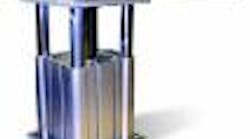Pneumatic lift table is a short, stable cylinder that incorporates four guide shafts for maximum rigidity. Designed for lifting applications where other nonrotating cylinders cannot handle an overhung load and space is at a premium. Available in three bore sizes: 50mm, 80mm, and 125mm; can produce 1900 pounds of lifting force at 100 psi. PTFE-impregnated hard anodized body yields low friction, maximum seal life. Options include internal bumpers, magnetic position sensing, high temperature operation. Stroke lengths are available in 5mm increments to 100mm.
Bimba Mfg. Co., (708) 534-8544, www.bimba.com


